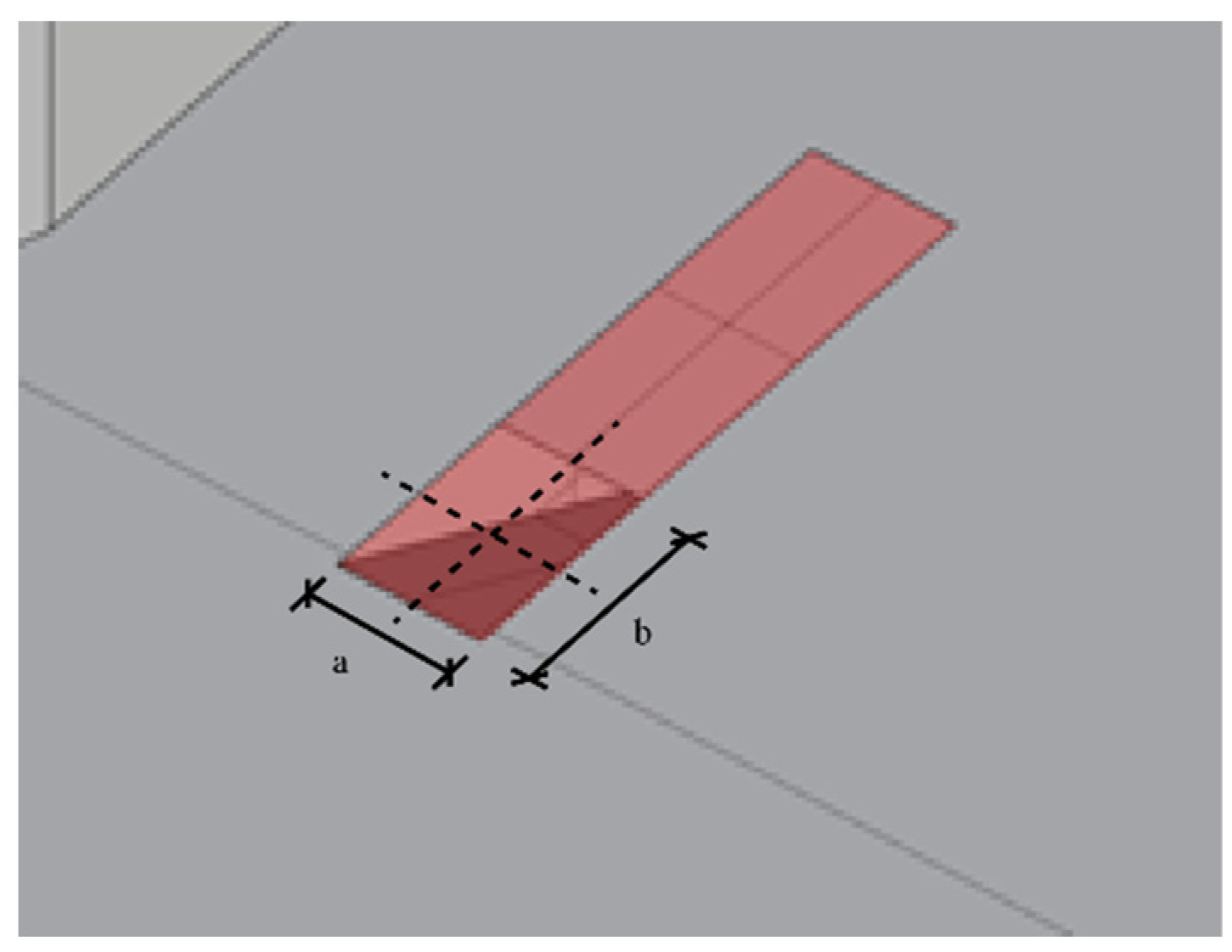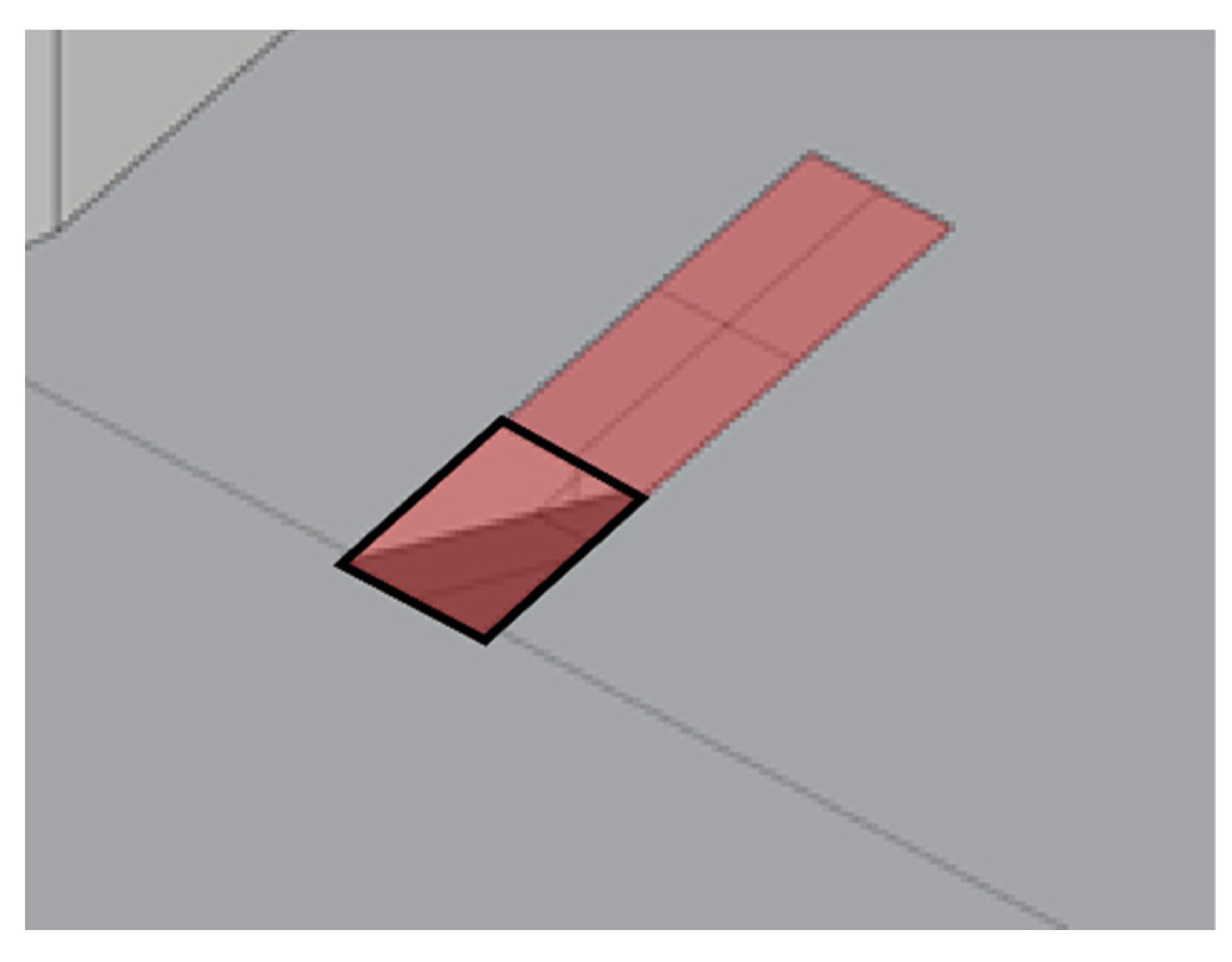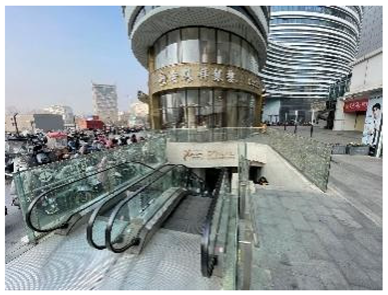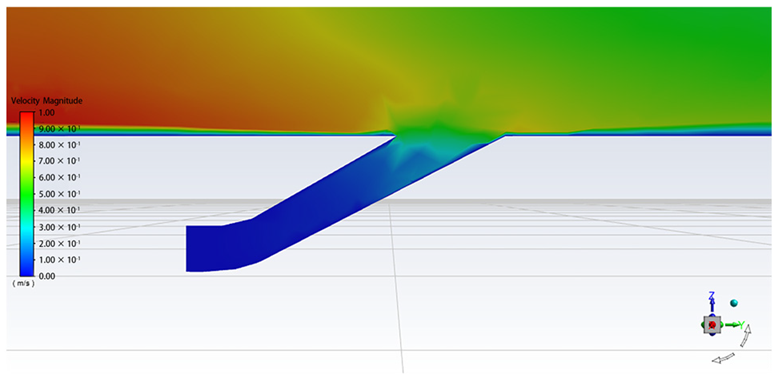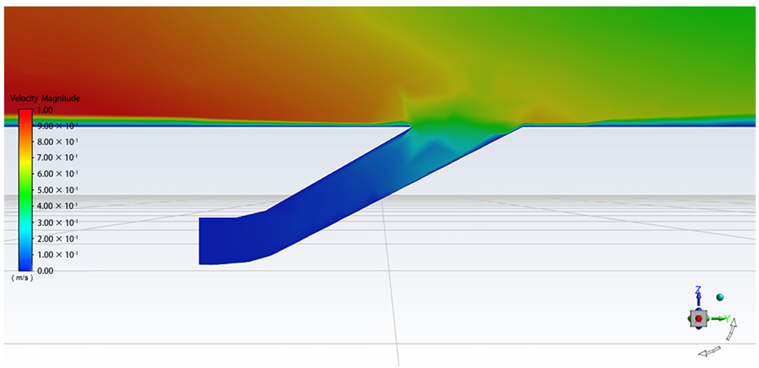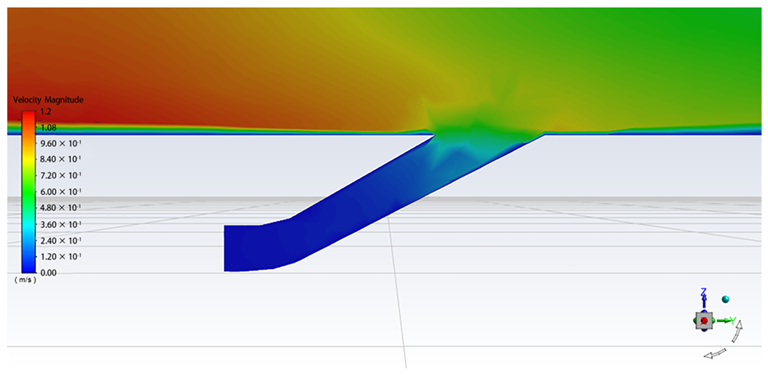3.1.1. Field Research
The types of entrances and exits of underground public Spaces are rich, and the design of space forms are also different. Therefore, the author conducted an in-depth investigation of the existing open underground public space entrances and exits, totaling 10. It covers the entrances and exits of underground public Spaces around Xuzhou Suning Square, Sanpower Square, Yunlong Campus of Normal University, Nanhu Campus of China University of Mining and Technology, and City Wall Museum.
Research site 1: The entrance and exit of the underground public space is located at the north side of Huaihai East Road and the west side of Pengcheng Road, Gulou District, Xuzhou City, Jiangsu Province, at the intersection of the two roads, which is the exit 5 of Pengcheng Square Station of Xuzhou Metro Line 1. From the ground, directly through the steps into the underground space, there is no shelter roof above.
Research site 2: The entrance and exit of the underground public space are located on the north side of Heqing Road and the west side of Pengcheng Road, Gulou District, Xuzhou City, Jiangsu Province. It is the entrance of the underground supermarket of Golden Eagle International Shopping Center and also exit 19 of Pengcheng Square Station of Metro Line 1. From the ground, directly through the steps into the underground space, there is no shelter roof above.
Research site 3: The entrance and exit of the underground public space is located at the north side of Heqing Road and the west side of Pengcheng Road, Gulou District, Xuzhou City, Jiangsu Province. It is the entrance and exit of the central Fashion Avenue and the underground pedestrian corridor at the intersection of the two roads. From the ground directly through the steps into the underground space, there is a semishielded roof above.
Research site 4: The entrance of the underground public space is located north of Huaihai East Road, Gulou District, Xuzhou City, Jiangsu Province, and south of Suning Square B1 south entrance. There is no shelter roof above from the ground directly through the steps into the underground space.
Research site 5: The entrance and exit of the underground public space are located near Sanpower Square, Tongshan District, Xuzhou City, Jiangsu Province, and the southwest entrance of the underground Food Street of Hi Street. From the ground through the steps, experience two turns into the underground food city, with no shelter above.
Research site 6: The entrance and exit of the underground public space are located near Sanpower Square, Tongshan District, Xuzhou City, Jiangsu Province, and the north entrance of the underground Food Street, Hi Street. There is an escalator above the shelter from the ground directly through the steps into the underground food city.
Research site 7: The entrance and exit of the underground public space is located at the north side of Heqing Road and the west side of Pengcheng Road, Gulou District, Xuzhou City, Jiangsu Province, at the intersection of the two roads, and is exit No. 18 in Pengcheng Square Station, Metro Line 1. There is no shelter roof above the ground directly through the steps into the underground space.
Research site 8: The entrance and exit of the underground public space is located in the underground city site Museum, Gulou District, Xuzhou City, Jiangsu Province. It is the north exit of the downtown Museum. There is no shelter roof above the ground directly through the steps into the underground space.
Research site 9: The entrance and exit of the underground public space is located in the City Wall Museum, Yunlong District, Xuzhou City, Jiangsu Province. It is the east exit of the City Wall Museum. There is no shelter roof above from the ground directly through the steps into the underground space.
Research site 10: The entrance and exit of the underground public space is located opposite the west gate of Wenchang Campus, Tongshan District, Xuzhou City, Jiangsu Province. Mine West Food City south entrance. There is no shelter roof above from the ground directly through the steps into the underground space.
According to the basic spatial characteristics of the research objects above, the entrances and exits of open underground public spaces are classified as shown in
Table 1. The following table lists the profile types of each open entrance and exit investigated and summarizes its basic spatial prototype.
3.1.2. Typical Inlet and Outlet Air Thermal Environment Measurement
(1) Summer
The environmental and physical parameters of the outdoor part, the transition part, and the indoor part in the three stages of the first group of open inlet and outlet conditions 1 and 2 in summer are shown in
Table 2. You can see from the table.
In condition 1, compared with the air temperature and the black globe temperature, the black globe temperature is generally higher than the air temperature, and the outdoor to indoor air temperature drops from 35.49 °C to 29.05 °C, with a more obvious drop.
The standard deviation of relative humidity in outdoor, indoor, and transitional parts is 1.12, 1.06, and 1.56, respectively, which are all higher than 1 and significantly higher than the standard deviation of other groups of data. In addition, the maximum and minimum relative humidity values of the three parts from outdoor to transition and then to indoor are 61.33 and 58.06%, 78.1 and 71.6%, 67.73 and 63.63%, respectively, and the fluctuation is also relatively obvious, indicating that the overall relative humidity of the underground public space entrance part of the working condition 1 has a large change range.
In terms of breeze wind speed, the outdoor wind speed fluctuates between 0.22 and 4.03 m/s, with an average of about 1.11 m/s; the indoor wind speed fluctuates between 0.46 and 1.65 m/s, with an average of about 0.91 m/s; the maximum wind speed in the transition part is 0.53 m/s, the minimum is 0 m/s, and the standard deviation is 0.12. It is possible that due to the relatively stable space of the transition part and the human environment, the wind speed is too small to be measured, and the overall wind speed change is not large.
Condition 2 is slightly different from condition 1. The overall black globe temperature is higher than the air temperature, and the outdoor to indoor air temperature drops from 34.44 °C to 30.92 °C. Compared with the same type of working condition 1, the temperature drop is small, and the temperature difference is more moderate. The standard deviation of the overall physical environment of the outdoor, transition, and indoor parts is 85% below 0.5, and only the relative humidity of the outdoor part is, with a maximum value of 64.36%, a minimum value of 58.63% and the standard deviation of 1.11, indicating a large overall fluctuation. Considering that there are some factors in the outdoor part of the working condition 2 that will change with changes in the outside world, it has an impact on the overall humidity.
In terms of breeze wind speed, the outdoor wind speed fluctuates between 0.1 and 0.53m/s, with an average of about 0.24m/s, and the indoor wind speed fluctuates between 0.12 and 0.63 m/s, with an average of about 0.24 m/s. The maximum wind speed in the transition part is 3.11 m/s, the minimum wind speed is 0.1 m/s, and the standard deviation is 0.57. The difference between the maximum wind speed and the minimum wind speed is large, but the standard deviation is not too high compared with the overall data, so it can be judged that the measured maximum wind speed should be an individual case.
Figure 4 shows the whole process change trend of working conditions 1 and 2 in summer. The data in the figure is the data change record of the whole process on a certain day under different working conditions in the same season. In the figure, 1–5 min represents the outdoor part, 6–10 min represents the transition part, and 11–15 min represents the indoor part. Combined with the above chart comprehensive analysis.
From the point of view of air temperature, the overall air temperature of working condition 1 and working condition 2 is relatively stable in each part, especially in working condition 2, there is almost no change. Compared with working condition 2, working condition 1 has a gradual upward trend in the transition part, and there are small fluctuations in the room within a certain range.
From the perspective of relative humidity, in the process of turning from the outdoor part to the transition part and then to the indoor part, the humidity of working conditions 1 and 2 showed a completely opposite trend; the humidity of working condition 1 showed an upward trend, while the humidity of working condition 2 showed a significant downward trend from the outdoor part to the transition part, and the overall average relative humidity from the transition part to the indoor part began to rise.
From the point of view of air velocity, the air velocity of working conditions 1 and 2 has the largest fluctuation in the outdoor part, and the overall wind environment is unstable, especially in working condition 1, which has great fluctuation. Not only that, the air velocity in the indoor part of working condition 1 also has a large fluctuation. Working condition 2 is generally smooth, and the wind environment is relatively stable, while working condition 1 only shows little fluctuation of the measured data in the transition part, and the wind environment is relatively stable.
Through the calculation of software, the PET values of the environment around the underground public space entrance and exit conditions 1 and 2 are obtained. It can be seen from the change of PET value with the slow walking process (
Figure 5) that the PET value in the outdoor part of working condition 1 is about 37.14 °C on average; when entering the transition part, the PET value drops to 34.92 °C; when entering the indoor part, the PET value drops to 29.88 °C and tends to be stable. The PET value of working condition 2 is about 30.58 °C on average; when entering the transition part, the PET value drops to 27.87 °C; when entering the indoor part, the PET value drops to 26.39 °C and tends to be stable. In the space from outdoor to indoor, the outdoor part has the highest PET.
(2) Winter
The environmental physical parameters of the outdoor part, the transition part, and the indoor part of the working conditions 1 and 2 in winter are shown in
Table 3. You can see from the table.
In condition 1, compared with the air temperature and the black globe temperature, the black globe temperature is generally higher than the air temperature, and the outdoor to indoor air temperature rises from 5.18 to 8.61 °C, with a significant increase.
The standard deviations of outdoor and indoor relative humidity are 0.26 and 0.62, respectively, while the standard deviation of the transition part is 1.47, which is much higher than the other two sets of data. In addition, the maximum and minimum values of relative humidity from the transition part are 34.8 and 30.6%, respectively, and the fluctuation is also relatively obvious, indicating that the relative humidity of the underground public space entrance and exit of the working condition 1 changes greatly in the transition part, and the environmental performance of the other two parts is relatively stable.
In terms of breeze wind speed, the outdoor wind speed fluctuates between 0.34 and 1.81 m/s, with an average of about 0.79 m/s; the indoor wind speed fluctuates between 0.28 and 0.48 m/s, with an average of about 0.36 m/s; the maximum wind speed in the transition part is 0.35 m/s, the minimum wind speed is 0.12 m/s, and the standard deviation is 0.06. Considering that the space of the transition part and the man-made environment are relatively stable, the overall wind speed changes little.
Condition 2 is slightly different from condition 1. Except that the overall black globe temperature is higher than the air temperature, the outdoor to indoor air temperature rises from 6.3 to 9.04 °C, which is smaller than the same type of working condition 1, and the temperature change is more moderate. The standard deviation of the physical environment of the overall relative humidity of outdoor, transition, and indoor parts is almost below 0.2, and the highest is only 0.19. Considering that the space and external environment of working condition 2 are relatively stable, the overall impact on relative humidity is small.
In terms of wind speed, the outdoor wind speed fluctuates between 0.3 and 3.66 m/s, with an average of about 1.45 m/s, and the indoor wind speed fluctuates between 0.39 and 1.18 m/s, with an average of about 0.66 m/s. The maximum wind speed in the transition part is 1.26 m/s, the minimum wind speed is 0.21 m/s, and the standard deviation is 0.25. The maximum wind speed differs greatly from the minimum wind speed, but the standard deviation is not too high compared to the overall data.
Figure 6 shows the whole process change trend of operating conditions 1 and 2 in winter. The data in the figure is the change record of the whole process on a certain day under different working conditions in the same season. In the figure, 1–5 min represent the outdoor part, 6–10 min represent the transition part, and 11–15 min represent the indoor part. Combined with the above chart comprehensive analysis.
From the point of view of air temperature, the overall air temperature of working conditions 1 and 2 in winter from indoors to outdoors is contrary to that in summer, showing a gradual upward trend. The temperature is relatively stable in each part, especially in working condition 2, where there is almost no big change. Compared with condition 2, condition 1 has a slight gradual upward trend in the transition part and the indoor part, and there are slight fluctuations within a certain range. In addition, compared with the transition part to the indoor part, the air temperature drop from the outdoor part to the transition part in condition 1 is larger and more sudden.
The blacksphere temperature is generally consistent with the air temperature, but there are differences. In condition 1, the outdoor black globe temperature is significantly higher than the air temperature, and the black globe temperature is almost the same as the air temperature after entering the transition part and the indoor part, with a difference of about 0.2 °C.
From the perspective of relative humidity, in the process of turning from the outdoor part to the transition part and then to the indoor part, the humidity of working conditions 1 and 2 is still the same as in summer, showing a completely opposite trend. The humidity of working condition 1 shows an overall upward trend, while the humidity of working condition 2 shows a significant downward trend from outdoor to indoor part.
From the point of view of air velocity, the air velocity of working conditions 1 and 2 has the largest fluctuation in the outdoor part, and the overall wind environment is unstable, especially in working condition 1, which has great fluctuation. Compared with the outdoor part, the other two parts change less. Working condition 2 is generally smooth, and the wind environment is stable.
Through the calculation of software, the PET values of the environment around the underground public space entrance and exit conditions 1 and 2 are obtained. It can be seen from the changes in PET value with the slow walking process (
Figure 7) that the physiological equivalent temperature PET of the outdoor part of working conditions 1 and 2 is not particularly stable, and the change is large. After entering the transition and indoor part, the physiologically equivalent temperature PET of both conditions has a great increase, with an increase of about 5–7 °C. In addition, the PET value of the outdoor part of working condition 1 is about 2 °C on average. When entering the transition part, the PET value rises to 8.61 °C, and when entering the indoor part, the PET value drops to 8.55 °C and tends to be stable. The PET value of working condition 2 is about 2 °C on average; when entering the transition part, the PET value rises to 4.73 °C; when entering the indoor part, the PET rises to 5.24 °C and tends to be stable. In the space from outdoor to indoor, the outdoor part has the lowest PET.
